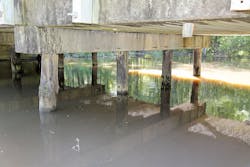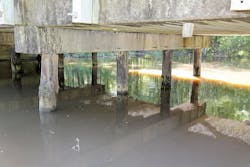Still in a lot of danger
Some would say Mississippi is fortunate not to see all four seasons.
The weather is on the mild side for much of the year. Yet things still shrivel up in the state and have to wait for conditions to improve.
On April 12, Mississippi Gov. Phil Bryant declared a state of emergency, issuing a proclamation ordering the Mississippi Department of Transportation (MDOT) to immediately close 83 city and county bridges. The number went up to 122, and may grow even higher in the coming months. In a letter to Bryant dated April 5, the Federal Highway Administration (FHWA) recommended 378 bridges for immediate closure. As late as March, the FHWA’s Mississippi Division allowed many of the bridges deemed deficient to remain open to the public, and the federal FHWA turned up the heat, threatening to withhold funding.
MDOT is not necessarily the culprit here. Instead, it is the enforcer. The Mississippi Office of State Aid Road Construction is the one that provides funding and enforces federal guidelines for county and city-owned bridges. None of the red-flagged bridges are the property of MDOT, but the agency was ordered to close the bridge by the governor. At press time, MDOT was in the process of contacting the counties to verify their intentions on closing the deficient bridges and giving them the opportunity to close the bridges within 24 hours of negotiation; visiting each bridge site for the bridges the counties will not close and determine what is needed for closure; securing barricades and the closure materials; and contacting the Mississippi Department of Public Safety and its own Office of Enforcement to have police present at the closure of the bridges.
“Public safety is always the Mississippi Department of Transportation’s and the governor’s top priority,” MDOT Executive Director Melinda McGrath said in a statement. “MDOT is thankful for the governor’s strong support of public safety while protecting federal transportation funds that come into the state.”
Mass bridge closings like the one in Mississippi have not been uncommon in the U.S., especially in the last decade. Some states are focusing more funding on bridges, but it is not enough from a national perspective. According to the American Roads & Transportation Builders Association (ARTBA), the number of structurally deficient bridges (rated “poor” by the FHWA) declined just two-tenths of a percent between 2016 and 2017.
The state of Mississippi has shut down 122 bridges, and more closures could be on the way. Decaying timber piles are mainly to blame.
A proactive California
According to ARTBA’s Most Traveled U.S. Structurally Deficient Bridges in 2017 list, the state of California owns five which land in the top 10, including U.S. Rte. 101 over Kester Avenue in Los Angeles County, which carries 289,000 vehicles a day and currently is the No. 1 most dangerous bridge in the country, and the Cherry Avenue off-ramp over the Rte. 405 northbound on-ramp in Los Angeles County, which carries 278,000 vehicles a day and sits at No. 2. Interstate 680 over Monument Boulevard in Contra Costa County is responsible for 235,000 vehicles a day and is currently the No. 4 most dangerous bridge, and the U.S. Highway 101 bridge over Sepulveda Blvd. (229,750 vehicles a day) is No. 6.
The California Department of Transportation (Caltrans), however, is making significant headway thanks to a change in direction with its Bridge Preservation Program. The number of poor bridges in California has been reduced 35% over the last five years, the result of getting a jump on bridge preservation. The agency also is required to produce a 10-year asset management plan.
“We made a conscious decision to shift funding from replacing and rehabilitating poor bridges to preserving the inventory of bridges in fair and good condition,” Michael Johnson, estate asset management engineer for Caltrans, told Roads & Bridges. “As a result of that change we have a measurable reduction in the number of bridges annually needing or being identified as rehabilitation and replacement candidates.”
The money also is flowing in. Caltrans is committing $5.5 billion over the next 10 years to improve bridge conditions, with over half of the money coming from SB 1: The Road Repair and Accountability Act of 2017. A fuel tax increase and other fees will generate $5 billion annually. So far SB 1 has funded 61 bridge projects, and 27 are scheduled to begin in 2018. In total, Caltrans will improve 270 bridges with SB 1 money, and the commitment is to fix 500 bridges over the next 10 years, with the goal of cutting the number of poor bridges in half.
SB 1, however, could be in danger. A movement has formed to repeal the gas tax increase by putting it on the November ballot. Caltrans could not comment on the threat.
As for the most dangerous bridges, Caltrans plans to take care of issues with the U.S. 101 bridge in 2019, and the Cherry Avenue off ramp over Rte. 405 is current being worked on. Caltrans is accepting bids for the No. 9 most dangerous bridge—I-710 over Noakes Street, which carries 220,000 travelers and also is located in Los Angeles County. All three projects involve work on the bridge decks.
Rapid program quickly ending
Pennsylvania also has been in the game of taking the poor out of bridges. Act 89 funding and the state’s Rapid Bridge Replacement Program has knocked a structurally deficient bridge list that was as high as 6,034 in 2008 down to 3,000. The goal of the Rapid Bridge Replacement Program, backed by a public-private partnership, was to replace a total of 558 bridges, and if everything goes according to plan that number will be reached at the end of 2018, which would bring the program to an end.
“We may have a handful of bridges that go into 2019, but it is our goal right now to get all of the bridges done in 2018, and we are working real hard to do that,” Gary Kleist, project manager for the Rapid Bridge Replacement Program, told Roads & Bridges. “I would say that PennDOT will use this as an excellent tool that we can use in our toolbox.”
After receiving a solid education during about a two-year learning curve, PennDOT cranked out over 200 bridge upgrades in 2017, leaving just 168 to complete this year. Working as many issues out as possible before hitting the project was one valuable lesson learned, as well as dealing with some foundation issues. PennDOT discovered that integral abutments work best with this program, as did predrilling in certain areas.
“It helped get us in and out much quicker,” said Kleist.
Bridge bundling has helped accelerate PennDOT’s progress. Bridge bundling involves grouping bridge projects together in the same region and letting it out to one contractor.
Now in its fifth year, Act 89 is expected to generate an extra $1.23 billion for highway and bridge work in 2018.
“We have hit the maximum funding [with Act 89] but that is continuing forward so I think that represents a very significant commitment on the part of the state to deal with roads and bridges,” PennDOT spokesman Rich Kirkpatrick told Roads & Bridges.
The Rapid Bridge Replacement Program may be a one-and-done. There is no talk on continuing the effort, but with the success of the program evident there is hope another one like it will be created and executed.
A new hope
The Missouri Department of Transportation (MoDOT) does not have a spending package to play with, but it is hoping some continuing education will break a voting mentality in the state. Since MoDOT is an independent agency most of its funding increases need to be approved on a ballot. For the first time in over 30 years, highway funding increase bills are moving through both the state House and Senate.
“The current strategy is really more of an education effort,” Dennis Heckman, state bridge engineer for MoDOT, told Roads & Bridges. “What we have focused on in the last year or so [with the public] is where the money comes from and where the money goes. It has been rather enlightening.”
Of Missouri’s 10,400 bridges, almost 10% are rated poor. MoDOT does its best to repair or replace, and every year they remove 100 spans from the deficient list. However, usually another 120 bridges in poor condition are added, and one—I-270 over Conway Road— is ranked No. 5 on ARTBA’s most traveled structurally deficient list. Interstate 70 over S.R. 141 was sitting at No. 3 after it was hit by a waste-hauling truck. Some steel girders had to be replaced while others were heat strengthened to take the span off the poor list. Interstate 270 has another crossing in St. Louis County that currently is the seventh-most dangerous in the U.S., but MoDOT plans on having it fixed in 2019.
Mississippi dispatched law enforcement to secure the 122 bridges it was forced to close due to structural deficiency.
UAV buzz kill?
Not long ago, unmanned aerial vehicles (UAV) were being hyped as the next great tool in bridge inspection. However, the flying drones are not taking over by any means. According to a survey by the American Association of State Highway & Transportation Officials, 35 state departments of transportation are using UAVs, but only 10 are using them for bridge inspections. Roads & Bridges conducted its own survey with state DOTs, and found that 43% are not engaging in UAV technology for bridge inspections, but 39% said they will be starting something up soon. Only 18% said they were fully engaged.
MoDOT is not planning on owning any UAVs in the coming years, but will call on vendors that specialize in the technology. Heckman said of Missouri’s 10,400 bridges UAVs might be useful on 15 of them.
“Many of the bridges are fracture critical and require hands-on inspection,” said Heckman.
PennDOT owns a drone, but is not using it for bridge inspections. The UAV has been used if there is an emergency with one of the bridges, but only to provide a preliminary view.
“Drones are good for a first glance, but to do an in-depth inspection and to confirm the safety you want to have hands on as much as possible,” Kris Langer, assistant chief bridge engineer for PennDOT, told Roads & Bridges.
Caltrans has shown interest in what UAVs can do, but as of now there is no program in place.
----------
Some illustrations in this section were made by Freepik from www.flaticon.com.






